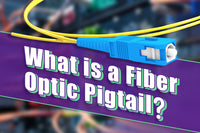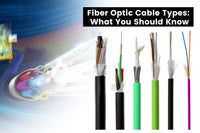Contents
Fiber optic network connections are preferred by more and more people thanks to their high speed, stability, and reliability. Achieving the optimal fiber network involves more than just laying down cables. For instance, joining fibers together can be necessary in some scenarios. That is why fiber optic splicing comes into play.
What is Fiber Optic Splicing?
Fiber optic splicing is the process of seamlessly joining two single fiber optic cables end to end to ensure a continuous path for optical signals. Splicing has a lower optical loss and back-reflection than other terminations, making it the ideal choice for maintaining signal integrity and reliability in fiber optic networks. Splicing usually provides a permanent solution and can be used to join different types of fiber optic cables. For example, a 36-core fiber can be spliced with three 12-core fibers extending in different directions.
Here are some scenarios where fiber optic splicing is needed:
- The existing fiber optic cable is too short, and you need to extend the length of the fiber to cover the desired cable run;
- Your cable got damaged by accident, and you need to cut and splice the broken part;
- The fiber length is too long for the desired cable run, and a splice is necessary to ensure the optimal performance of the fiber optic cable;
- Two optical fiber cables should be joined to expand the fiber optic network from one place to another.
Types of Fiber Optic Splicing
Fiber optic splicing creates an accurate connection between fiber cores and involves delicate operations such as fiber stripping, fiber cleaving, core aligning and coupling, etc. There are generally two methods of optic cable splicing: mechanical splicing and fusion splicing.
Mechanical Splicing
Mechanical splicing usually requires a plastic or glass alignment device and index-matching gel. The alignment device is designed to precisely align the fibers and hold them firmly in place. The index-matching gel is used to fill the air gap between fibers. It should have a similar refractive index to the fibers to improve light transmission and reduce fresnel reflections and losses. Mechanical fiber splice does not require fiber melting, and the two fiber ends are not spliced into a solid piece. The splicing method can be used for both single-mode and multimode fibers.
Mechanical splicing uses no power supplies and only a few tools, making it easy to operate and ideal for temporary splicing and pre-terminated cables. However, it can result in an insertion loss of 0.3 dB, which may impact the light transmission efficiency.

Fusion Splicing
Fusion splicing refers to the process of melting and fusing two fiber cores to a permanent connection using an electric arc or other types of heat, which creates a continuous fiber pathway. Fusion splicing is preferred by professionals if possible, and it is a reliable option for joining single-mode fibers.
Compared to mechanical splicing, fusion splicing creates a more reliable joint with nearly no back reflections, and its typical insertion loss can be less than 0.1 dB. However, the fusion splicing requires high precision and meticulous operation, as any misalignment or errors can result in a poor connection. Moreover, it also relies on expensive specialized equipment like fusion splicers. Fusion splicing works well in long-term projects and high data-rate communications over long distances.

How To Splice Fiber Optic Cables?
Splicing fiber optic cable indeed requires precision and the right tools. Let’s delve into the essential equipment for fiber optic splicing and explore step-by-step processes for both mechanical splicing and fusion splicing. Here is the rundown of necessary tools and equipment for fiber optic splicing:
Fiber Stripper: Used to remove the cladding and coating of optical fibers and expose the bare fiber.
Cleaning Tools: Cleaning tools are needed, such as isopropyl alcohol, lint-free wipes, and swabs to clean the bare fiber after stripping.
Fiber Cleaver: Used to cut the fiber accurately, making sure a smooth fiber end surface for splicing.
Splicer: The mechanical splice is a self-contained device designed for mechanical splicing, which contains the alignment device and index-matching gel.
The fusion splicer is required in fusion splicing to align the fibers and adopt an electric arc to melt fiber ends. This fiber optic splicing machine can be classified into core alignment fusion splicer, cladding alignment fusion splicer, hand-held fusion splicer, single fiber splicer, and ribbon fiber splicer designed for fusing fiber ribbons.
Heat Shrink Sleeve: Used to encapsulate and protect the joint after fiber fusion.
How to Perform Mechanical Splicing?
Let’s further explore the details of how to perform mechanical splicing.
- Fiber Preparation and Clean
Use the fiber stripper to remove all armor, jacket, cladding, and coatings from the optical fiber, leaving the inner bare fiber. Then clean the bare fiber with fiber optic cleaner and wipes.
- Fiber Cleaving
Use a fiber cleaver to cut the bare fiber to an appropriate length. The cutting end surface should be perpendicular to the fiber axis, and you should carefully clean it if there is any debris.

- Mechanical Joining
Precisely insert two fiber ends into the fiber optic mechanical splice so that two fiber ends can maintain contact with each other with the index matching gel inside. Check whether the splicing is successful and fasten the splicing unit.
- Fiber Protection
The mechanical splice itself acts as a protective barrier for the splice. Besides, the spliced fiber cables can be further placed into a splice tray to prevent impact and moisture.
How to Complete Fusion Splicing?
Fusion splicing is similar to mechanical splicing in some steps, but there is a main difference: it uses a fusion splicer to melt and fuse the fiber. The fusion splicing process is broken down into six steps.
- Fiber Insertion
Insert one of the optical fibers in the heat shrink tube before stripping. The heat shrink tube should be put on the fiber in advance to protect the splice after fusion.
- Fiber Stripping
Just like mechanical splicing, strip the fiber cable using a fiber stripper to expose the bare fiber.
- Fiber Cleaning
Use isopropyl alcohol (IPA) and wipes to clean away dust and particles. Once cleaned, avoid touching the bare fiber.
- Fiber Cleaving
The fiber cleaving accuracy is more significant in fusion splicing than mechanical splicing. Use a fiber cleaver to precisely cut the fiber at a 90° angle and create a mirror-smooth flat break perpendicular to the fiber axis. A cleaver with a built-in fiber fragment collector is also recommended.
- Fiber Splicing with the Fiber Cable Splicer
This step involves the alignment, melt, and fusion of fibers. The fiber end faces can be aligned automatically or manually depending on different fiber optic fusion splicers. Once aligned, the electric arc melts fibers and permanently fuses fiber ends.
- Protective Sleeve Shrinking
Slide the heat shrink tube to cover the exposed fiber, and then heat it using the built-in heat-shrinking slot of the fiber fusion splicer to seal and protect the splice.
Fusion Splicing vs Mechanical Splicing
Which one should you choose between fusion and mechanical splicing? Fusion and mechanical splicing have their own advantages and disadvantages. Factors like performance, budget, and specific splicing needs should be mainly considered in your decision-making process.
Compared to mechanical splicing, fusion splicing provides lower insertion loss, better signal integrity, and long-term stability and durability.
Mechanical splicing offers a cost-effective solution with a relatively low initial investment, but each mechanical splice will cost. On the contrary, fusion splicing requires high upfront costs due to the pricey fusion splicer, yet it costs less per fusion splicing. While mechanical splicing is suitable for occasional use, fusion splicers are a worthwhile investment for professional carriers thanks to their precision and reliability.
Fusion splicing is the preferred method for a wide range of applications, such as telecommunications, cable TV networks, and local optical networks (LONs). However, fusion splicing may be hard to implement in certain environments. For example, situations where achieving fusion is difficult, the fusion splicer is too large to be used, or access to electricity is limited, may necessitate the use of mechanical splicing as the most feasible option. Mechanical splicing is also ideal when quick repairs are needed to restore signal transmission.
Below is a comprehensive comparison table of these two fiber optic splicing methods.
|
|
Mechanical Splicing |
Fusion Splicing |
|
Cost |
Low costs |
High costs |
|
Signal Loss |
Low |
Minimum |
|
Back Reflection |
Low |
Minimum |
|
Tensile Strength |
Common |
High |
|
Flexibility |
Adapt to frequent alteration and repairs |
Unsuitable for changes or rework |
|
Duration |
Temporary or semi-permanent |
Permanent |
|
Accomplish Time |
Quick |
Slow |
|
Applicability |
Applicable to single-mode fiber and multimode fiber |
More suitable for single-mode fiber |
|
Power Source |
No electricity required |
Electricity needed |
|
Personnel Demand |
Requires minimal training |
Requires specialized training |
|
Reliability |
Unsuitable for long-term use in harsh environments |
High reliability |
|
Fiber Condition |
Not continuous |
Continuous |
Tips to Ensure Quality Fiber Optic Splicing
- Clean the splicing tool regularly.
- Carefully maintain the cleaver and clean it according to the manufacturer's instructions.
- Adjust the parameters of the fusion splicer, such as fusion time and current, to adapt to different types of fibers.
- Test the spliced fiber performance with professional test equipment to ensure it can work well.
Applications and Future Trends
Fiber optic splicing is essential in fiber optic networks, long-distance telecommunications, FTTX deployments, data centers, and more. Understanding the knowledge of splicing can help you make a perfect fiber connection.
As technology evolves, you may expect some upgrades in splicing technology. For example, there may be more environmentally friendly mechanical splicing with reduced light loss; Fusion splicers might become more compact; Ribbon fusion splicers may become popular to improve efficiency and facilitate the deployment of fiber optic networks.
FAQ
How does a fiber optic fusion splicer work?
Firstly, the fusion splicer helps correct the placement of fibers to ensure they are correctly aligned; secondly, the fusion splicer helps eliminate dust and moisture and improve the purity of the splice; finally, the fusion splicer heats and fuses the fiber ends to achieve a permanent splice with minimal loss.
Can I splice fiber optics at home?
Fiber optic splicing requires specialized tools and skills. If you want to splice the fibers yourself at home, gather the necessary tools and do some practice before you start. If you are worried about the splicing performance, it is advisable to seek help from a trained professional.
What is the difference between splicing and fiber optic connectors?
Fiber optic connectors are installed at the end of fiber cables or optical equipment. They feature a plug-and-play design, which is easy to use. In contrast, fiber optic splicing refers to permanently joining two fiber optic cables together, providing a firm and reliable connection with low insertion loss.
For more information on this topic, you can keep up on our blogs. While VCELINK offers general and basic information for our customers and other visitors to the website, it’s not professional advice.



Be the first one to comment.
Leave a comment